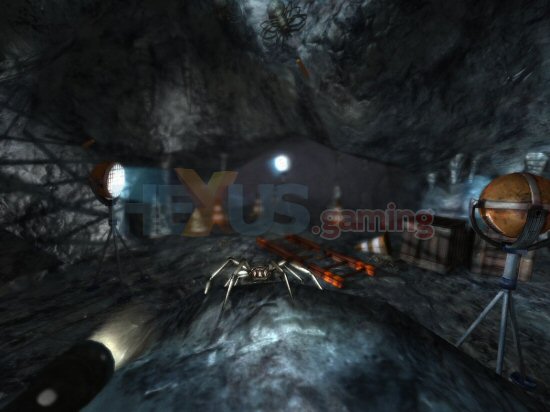Mouse interaction - Throw stuff about...
Our preview began with a short tutorial which sees the story's hero, Phillip in a cabin on a ship heading towards Greenland. Movement is controlled via the standard W, S, A, D buttons, while Phillips’s head is controlled by the movement of your mouse. Whilst Phillip’s movement isn’t restricted it does mean that you need to constantly move your mouse around in order make turns, but it does mean that interacting with the environment and searching for objects is easy. At first glance, the scene is littered with the same sort of items and objects that you’ll see in many point and click adventures; a readable note on a table, a map, a set of drawers with a key inside, a chest in the corner and a locker containing a torch (crucial to any horror adventure!). The difference between Penumbra Overture and many other games of the same ilk is that you can and often need to manipulate objects using mouse interaction order to solve puzzles.
Although Penumbra Overture is billed as a first person action game it also incorporates challenging puzzles and the combining of items in your inventory in order to reach a solution. This gameplay style, more commonly seen in point and click adventures, and the combination of combat and physics interaction, make Penumbra Overture unlike any other game we’ve personally experienced.
 Click for larger image
Click for larger imageSwedish developer Frictional Games has developed the real-time 3D engine in-house and throughout the game you can interact and manipulate many objects, sometimes for the plain hell of it (pick up a whisky bottle and smash it against a wall - hell yeah!) and other times in order to solve a puzzle. For example, opening a door isn’t simply a matter of clicking a button, you’ll have to mimic the action by moving your mouse forward or backwards. Other examples include using a broomstick to knock an item of a shelf by holding down the mouse button moving it forward and then shifting it to the left and right to create the swinging motion or circling the mouse in order to rotate a valve.
 Click for larger image
Click for larger imageThe interactivity does make the gameplay far more interesting than the usual point and click style and it becomes a fairly intuitive reaction to stack crates, turn switches or open doors. The puzzles that we encountered were fairly difficult; in fact we have to admit to reading the accompanying walkthrough (something we sometimes need to do to save a bit of time!) in order to solve one of the first puzzles we encountered. The cursor on the screen is represented by an eye or a hand. When the eye icon is present it means you can examine an object and when the hand is on screen you can interact with that object; icons appear only when you hover over an object or item that you can interact with. Searching for one particular clue did become frustrating and after spending a good 20 minutes wondering how on earth we could start a broken generator, we glanced at the walkthrough to discover that we’d missed a fuse that was perched high on top of a set of shelves. Without the item, the puzzle could not be solved,; we dare say that it would have taken us quite a long time to find it. Frictional Games are still in the process of changing things within the game and personally we hope that there aren't too many of these hidden objects to find.









